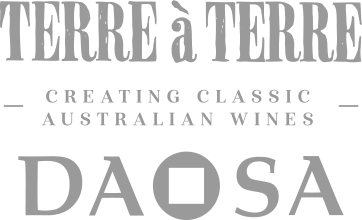Huon wrote some nice words just before vintage 2018 on how we are trying tp do our best with our Cabernet Sauvignon from Crayères Vineyard!
Source: therealreview.com.au
Link: https://www.therealreview.com/2018/03/13/xavier-bizot-is-bringing-cabernet-back/
Date: 13 March 2018
“Xavier Bizot of Terre à Terre seems a little irritated that South Australia’s south-east, in particular his region Wrattonbully, and his favourite grape cabernet sauvignon, aren’t getting enough attention.
“In the end, the consumer will have to understand that they might like drinking pinot noir, but maybe they should drink some cabernet too.”
He says cabernet is a great variety for Australia.
“There are so many well-established cabernet vineyards, and they are not in big demand because the demand from the market is slack. But the statistics show that there is a massive amount of cabernet in good areas.”
He says the best four hours of his year are when he lines up the samples from each barrique of the new vintage cabernet, and puts his blend together. “The most important thing in winemaking is the blending.”
Bizot says the problem with cabernet in the south-east is poor canopy management.
Spoken like a Champenois – Xavier is a member of the family that owns Champagne Bollinger(“It’s one of only three major Champagne companies that are still family-owned”) and he is a member of its board. But he lives in South Australia with his wife Lucy and children, and works in the Adelaide Hills beside his father-in-law, Brian Croser. His and Lucy’s company is Terre à Terre, which makes red and white wines grown on their own vineyard at Wrattonbully, and sparkling wine Daosa from the Adelaide Hills’ Piccadilly Valley.
The sparkling is a vintage blanc de blancs produced from two vineyards. They are the Bizot vineyard, which was planted by Xavier’s father, the former managing director of Bollinger Christian Bizot; the second is a vineyard which was planted by former Treasury and Yellowglen chief sparkling winemaker Charles ‘Chilly’ Hargrave, now retired.
The wine has a Bollinger echo in that barrels are used (in Daosa’s case large foudres), and it’s a very dry wine. But it’s also pure chardonnay, which is decidedly not Bollinger style. Xavier has recently taken on the management of a third, 23-year-old Piccadilly vineyard, which has pinot noir as well as chardonnay, so perhaps there will eventually be a Daosa blend.
But back to cabernet.
Wrattonbully is a great area. It has great potential. Treasury Wine Estates is sourcing more and more fruit from Wrattonbully for Penfolds.
Bizot says the problem with cabernet in the south-east is poor canopy management. It’s often an ‘Australian sprawl’ – untidy, lazy, and bad viticulture. “In Margaret River, they pay more attention to their canopy management.” But he believes Coonawarra and Wrattonbully are better regions for cabernet than Margaret River. However, he admits Margaret River is currently doing a better job.
“Wrattonbully is a great area. It has great potential. Treasury Wine Estates is sourcing more and more fruit from Wrattonbully for Penfolds. Peter Gago (Penfolds’ chief winemaker) was recently talking it up to a visiting group of sommeliers. He is a big supporter. One of Wrattonbully’s advantages is that it doesn’t get frosted. This year Coonawarra and Padthaway were frosted, but Wrattonbully was protected by its big swamp, which is dry now but contained water when the frost came in spring, and the water moderated the climate, so Wrattonbully wasn’t touched.”
The 2015 Terre à Terre Crayères Vineyard Cabernet Sauvignon (AUD $40) is a serious cabernet, elegant and well-structured with properly ripe fruit flavours. The Terre à Terre Crayères Vineyard Reserve Cabernet Sauvignon Cabernet Franc 2014 (AUD $55) has little more concentration and fleshiness, firmer tannins and bigger structure, and will probably age longer.
It’s tempting to draw parallels with Croser’s Tapanappa Whalebone Vineyard reds from the same area, but they’re from a different vineyard and the style is also different. To generalise, Tapanappa’s wines are more savoury, with drier tannins, less primary fruit and more wood-maturation influences.
Bizot is also a big believer in cabernet franc, and his 2015 is a lighter-bodied wine with some mint and herb aromatics. It’s good drinking now but probably not for long keeping.
An exciting sidelight is the 2016 Terre à Terre Crayères Vineyard Sauvignon Blanc (AUD $30), an oak-influenced, barrel-fermented style, which stands comparison with a very good Bordeaux blanc. Rich, spicy, nutty, undoubtedly varietal but also very complex and satisfying to drink. Bizot says it’s a style that needs time: the 2012 is drinking well now.
Terre à Terre means ‘down to earth’, which is a kind of play on words. It evokes the idea of seeking terroir in wine; it also references Bizot’s travelling the world and finally coming to earth in South Australia, where he has settled down and become a confirmed Aussie. Except for that French accent.
Bizot has some views about commitment. First a Frenchman, now an Australian, he is investing all he can afford in Australia. It puzzles him that others are not so dedicated. In France, vineyards are a winemaker’s most important asset.
“One of the things that struck me about Australia when I came here was how little equity people have in vineyards. Even in the Adelaide Hills, people cherry-pick. They need to invest time and effort in developing their own vineyards. It’s a long-term thing. You need to make sure your vines are in the right place, and then put in the time and effort.”
This is where family companies have an edge. “They take the long-term view.”



